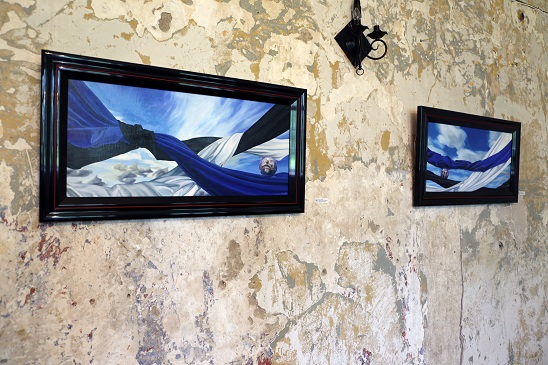Time has also left its mark on Lihula manor. Despite the plaster dust crumbling from the walls, the heart of the manor still leaves a majestic impression. The building stands out among manors in Lääne County with its grandiose style of construction. The elapsed time has imparted a certain character upon the manor, making it a unique exhibition site. Dilapidated walls meet elegant art at Lihula manor during Mall Nukke's exhibition Estonian Manor Landscapes. The exhibition offers a refreshing alternative to the image of art that is traditionally associated with manors. This is a good example of how contemporary painting and classicist manor ensembles comprise a unique and harmonious whole.
The structure, with its demanding and strong historical legacy, may, in its grandeur, impart a suffocating effect, although Nukke’s paintings are an equal partner to the building. Her works are able to establish themselves in the interior, without conflicting with the historic cultural heritage. Nukke’s paintings radiate intrinsic value, which makes the works both revealing and independent. They resonate together with the room, constituting a functioning whole. An excellent contrast is offered to the decorated works by the somewhat dilapidated walls of the heart of the manor. Mall Nukke personally notes that the completed realistic works fit in well with the ‘impressionistic picturesqueness of the walls’.
The manor house possesses a classicist type of dignity, which brings forth a presentable note in the paintings. The elegance radiating from Nukke’s works fits in harmoniously with the profile of the room. The decorous atmosphere is an ideal companion for beautiful paintings. Luxuriously flowing fabrics and the shimmering glass beads between them have an especially appropriate affect in this aristocratic environment. As with the shimmering glass beads on Nukke's fabric landscapes, manor complexes cover Estonia like pearls. The Vaikelu series, featuring Estonian weather, depicts manors placed in glass pearls, against fabric backgrounds of blue black and white. A familiar note of fragility is expressed in the majestic background, which also speaks of uncertainty. Physically this could be associated with the decaying of the buildings, although on a spiritual level it refers to the fragility of our independence.
The works on display at the exhibition carry within themselves a connection between the cognitive and the emotional. According to the artist, the paintings express festiveness, tradition and history. A sense of measure and historic character are given to the exhibition by the use throughout of the colours of the tricolour. The intrinsic significance of the colours in the paintings resonates more strongly when placed in a historic context. Woven into the colours of the tricolour are the events of the past and future endeavours, spiritual struggles, and feelings of hope. The essence of Estonianness has been consolidated within the works.
Against the background of the richness of meaning of the paintings, the works do not leave the impression of being overly serious and reserved. The glass beads that have been strewn across the paintings add playfulness. A sense of lightness is also brought into the works by the floating fabrics. The large dimension paintings from the series Mäng kolmevärviliste munadega I-IV (Game with Tricoloured Eggs I-IV), hung in the ground floor café, convey a greater feeling of freedom. Splashes of colour that enliven the paintings have been applied to the canvas. The play of colours and fabrics flowing in the paintings make the tired interior of the manor resound.
Mall Nukke’s paintings constitute refined and professional contemporary art. The works exhibited in the heart of the manor do not conflict with their environment, but instead have an appropriate and fresh influence in the manor context. The historic interior supports the meaning of the works and amplifies their emotional value, in particular the new owner of each exhibition work will also become a patron along the lines of the former lord of the manor – the sale of the works supports Hummuli Manor School, the site of the final concert in the charity concert series Estonian Manors 2017.
Kaia Kodasma
Haus Gallery has cooperated with the new Web magazine Edasi (in English Forward) (Edasi.org). In the weekly column we talk about something interesting and noteworthy in the field of art to Estonian readers. The Forward way of thinking, positive world view, intelligent journey with the reader through meaningful moments, slow journalism, which offers counterpoise to the racy information barrage, which invites to stop, feel and think along just as art inspires Haus Gallery to write stories for Forward.
.png)
